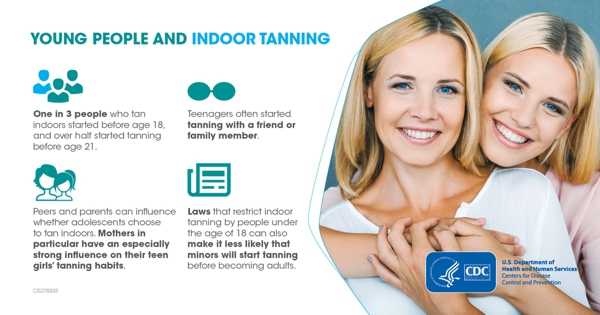Parents and Friends Can Influence Teens’ Decisions About Starting Indoor Tanning
To protect young people from greater risk of skin cancer, parents and other mentors can talk to them about the dangers of UV rays from tanning, discourage them from starting to tan when they are young, and set a good example by avoiding tanning themselves.
Teens and young adults are more likely to start indoor tanning when they are young, especially if they think that it’s okay with their parents and friends. When it comes to decisions about indoor tanning, families and friends are often the best messengers of safe practices—with their actions and their words—especially for young people.
Using a tanning bed, booth, or sunlamp to get tan is called indoor tanning. Exposure to ultraviolet (UV) rays while indoor tanning can cause skin cancers including melanoma (the deadliest type of skin cancer), basal cell carcinoma, and squamous cell carcinoma. Exposure to UV rays also can cause cataracts and cancers of the eye (ocular melanoma).
How Tanning Can Cause Skin Cancer
Skin cancer is a major health risk, especially melanoma. In 2013, more than 70,000 people in the United States got melanoma, and more than 9,000 people died from it. Most cases of melanoma are caused by too much exposure to UV rays, which come from both the sun and tanning beds. UV rays can make your skin get darker. A tan is your body’s response to injury, because skin cells signal that they have been hurt by UV rays by producing more pigment.
About the Study
The study described in this article by the authors tried to understand more about why people start indoor tanning. The scientists used survey answers about whether they had ever used indoor tanning equipment (a tanning bed, tanning booth, or tanning lamp). Those who had were asked follow-up questions about their age when they first tanned, and whether someone else—like a friend or family member—had been with them.
Key Findings
Of the 977 people in the study (252 males and 725 females)—
- More than half began indoor tanning before they were 21 years old.
- About one-third of people who tanned indoors were younger than 18 years old when they started.
- More than half of teens and young adults started tanning alone.
- Teens who started tanning before turning 16 years old were most likely to start tanning with a family member, usually their mother.
- Older teens often tanned with a friend.
- What parents and friends think about indoor tanning makes a difference in whether young people start tanning. This is especially true of mothers and daughters.
Citation
Watson M, Shoemaker M, Baker K. Indoor tanning initiation among tanners in the United States. JAMA Dermatology 2017;153(5):470–472.
More Information
Image to Share
- Page last reviewed: May 30, 2017
- Page last updated: May 30, 2017
- Content source:
- Maintained By:


 ShareCompartir
ShareCompartir
